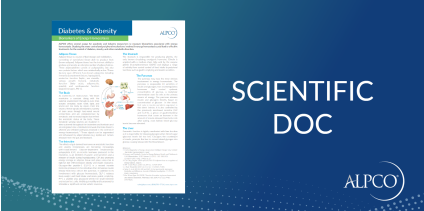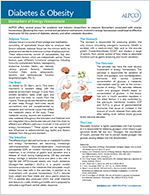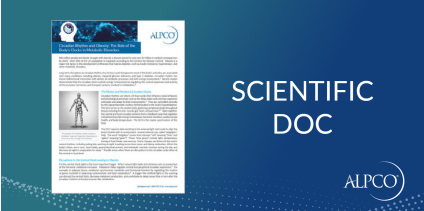Understanding the Role of Energy Homeostasis in Diabetes
Introduction
The prevalence of diabetes and obesity has been on the rise for several decades, and research has demonstrated that other parts of the body, including the cardiovascular system and kidneys, can be affected by diabetes. The key to understanding the relationship between diabetes and these other areas begins with the role of energy homeostasis in diabetes. At the same time, investigators are utilizing various biomarkers that have been shown to help further diabetes and obesity research.
The key to understanding the relationship between diabetes and these other areas begins with the process of energy homeostasis and the important biomarkers used in today’s research.
Role of Energy Homeostasis in Diabetes
Energy homeostasis is a well-regulated process that depends on the coordination between feeding behavior and energy expenditure. The control of energy homeostasis in humans has received much attention in recent years due to alterations caused by the onset of conditions such as obesity and diabetes.
A variety of organs tightly control energy homeostasis, including the:
- Pancreas
- Stomach
- Intestine
- Brain
- Liver

The Importance of the Pancreas
The pancreas is one of the most important organs involved in maintaining energy homeostasis because it is responsible for the secretion of insulin and glucagon. Insulin and glucagon are two counter regulatory hormones that control the systemic concentration of glucose, a metabolic intermediate used by cells as the primary source of energy. If glucose homeostasis is thrown off balance, a diabetic state develops.
What is Diabetes?
Type 1 Diabetes (T1D, Juvenile Diabetes)
Type 1 diabetes is an auto-immune disease that results in the destruction of β-cells in the pancreas1. With the destruction of β-cells, the body cannot produce enough insulin to maintain energy homeostasis. The onset of type 1 diabetes typically occurs in children and young adults1.
Type 2 Diabetes (T2D, Adult Onset Diabetes, Noninsulin Dependent Diabetes)
Type 2 diabetes occurs when the body has built up insulin resistance, causing glucose levels in the body to increase by preventing glucose uptake into cells1. The onset of type 2 diabetes usually occurs in adults1.
Diabetes and Obesity Biomarkers Making a Difference in Research
Research in diabetes and obesity is more important than ever. Obesity in the US continues to increase at alarming rates. Diabetes is closely related to obesity, so the increase in obesity has had an impact on the number of people with diabetes.
Several biomarkers are making a difference in diabetes and obesity research. These biomarkers include proinsulin, C-peptide, adiponectin, glucagon-like peptide-1, and glucagon. Research groups have been working diligently to expand the knowledge of these markers.
Proinsulin (PI, PIN)
Proinsulin is a precursor molecule of insulin (INS) and C-peptide (CP) that is synthesized by pancreatic ß-cells within the Islets of Langerhans2,3,4. Measuring proinsulin is a window into β-cell function5,6.
C-peptide
C-peptide is the amino acid sequence linking the A and B chains of the proinsulin molecule together, and its secretion can be linked to β-cell response to glucose7,8,9.
Adiponectin (ADP)
Adiponectin is a 244 amino acid protein exclusively secreted from adipose (fat) cells and is very abundant in plasma (~5-10 μg/mL)10,11. This “adipocytokine” is a strong indicator of insulin sensitivity and resistance12.
Glucagon Like Peptide-1 (GLP-1)
GLP-1 is produced in intestinal L-cells in response to food and is well-conserved across species. The peptide has many physiological effects on the body, including influencing insulin secretion13.
Glucagon
Glucagon is produced by α-cells in the pancreas in response to low circulating glucose14 and is essential for the maintenance of normal blood glucose in diabetes15.
Summary
Understanding the role of energy homeostasis in diabetes is essential to understanding the disease. The pancreas is important in maintaining this energy balance in the body. Diabetes develops when there is a disruption of energy homeostasis, and the form of the disease depends on how the imbalance occurs. The biomarkers discussed here are helping researchers to understand energy imbalances and diabetes further.
References
- Pipeleers et al. (2008). Restoring a functional ß-cell mass in diabetes. Diabetes, Obesity and Metabolism, 10(4), 54–62. PMID: 18834433
- Zambre et al. (1998). Effect of glucose on production and release of proinsulin conversion products by cultured human islets. Journal of Clinical Endocrinology & Metabolism, 83(4). doi: http://dx.doi.org/10.1210/jcem.83.4.4715
- Given et al. (1985). Biochemical and clinical implications of proinsulin conversion intermediates. Journal of Clinical Investigation, 76(4), 1398-405. PMID: 3902891
- Mackin. (2007). Proinsulin Processing-in vivo [Image].
- Grill et al. (2002). Hyperproinsulinemia and proinsulin-to-insulin ratios in Swedish middle-aged men: Association with glycemia and insulin resistance but not with family history of diabetes. American Journal of Epidemiology, 155, 834–41. PMID: 11978587
- Verchere. (2014). Proinsulin, Insulin, and Beta Cell Dysfunction Presentation. University of British Columbia and ALPCO. ALPCO.com.
- Polonsky et al. (1986). Use of biosynthetic human C-peptide in the measurement of insulin secretion rates in normal volunteers and type I diabetic patients. Journal of Clinical Investigation, 77, 98–105. PMID: 3511094
- Licinio-Paixao et al. (1986). Ingestion of a mixed meal does not affect the metabolic clearance rate of biosynthetic human C-peptide. Journal of Clinical Endocrinology & Metabolism, 63, 401–403. PMID: 3722329
- Jones & Hattersley. (2013). The clinical utility of C-peptide measurement in the care of patients with diabetes. Diabetic Medicine, 30, 803–817. PMID: 23413806
- Inadera. (2008). The usefulness of circulating adipokine levels for the assessment of obesity-related health problems. International Journal of Medical Sciences, 5(5), 248–262. PMID: PMC2528071
- Jazet & Meinders. (2007). Adiponectin, role in insulin resistance, atherosclerosis and carcinogenesis. Ned Tijdschr Klin Chem Labgeneesk, 32(1), 8-12.
- Kadowaki & Yamauchi. (2005). Adiponectin and adiponectin receptors. Endocrine Reviews, 26(3), 439–451. PMID: 15897298
- MacDonald et al. (2002). The multiple actions of GLP-1 on the process of glucose-stimulated insulin secretion. Diabetes, 51(3), S434-S442. doi: 10.2337/diabetes.51.2007.S434
- Drucker & Nauck. (2006). The incretin system: glucagon-like peptide-1 receptor agonists and dipeptidyl peptidase-4 inhibitors in type 2 diabetes. Lancet, 368(9548), 1696-705. PMID: 17098089
- Drucker & Campbell. (2015). Islet α-cells and glucagon—critical regulators of energy homeostasis. Nature Reviews Endocrinology, 11(6), 329-339. PMID: 25850661






